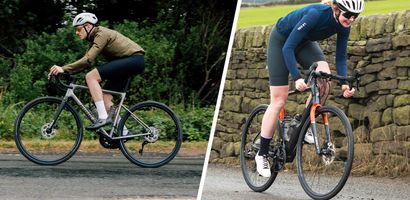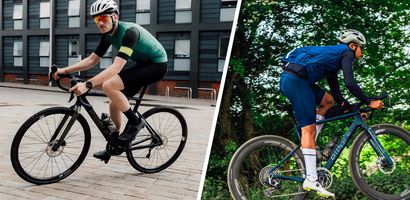
Do You Really Need a Winter Bike? Benefits, Setup & Key Features
When the clocks go back and the roads turn wet, gritty, and unpredictable, many riders ask the same question: “Why can’t I just ride my normal bike through winter?”
Technically, you can - but that doesn’t mean you should. A dedicated winter bike isn’t just about tradition; it’s about protecting your best bike, keeping training consistent, and making every mile through the colder months more enjoyable. Here’s why it matters.
What Is a Winter Bike?
A winter bike is essentially a workhorse for the colder months. It’s designed to take on rain, grit, and freezing roads without complaint, often featuring:
- Geometry: Endurance-focused geometry for comfort and stability on longer rides.
- Mounts: Proper mudguard and rack mounts to fend off spray and carry extra kit.
- Durability: Frames built from aluminium, steel, or titanium to take the knocks of harsher conditions.
Think of it as your reliable training partner that saves your best bike for when it matters most.
Why Consider a Winter Bike?
So, do you really need a winter bike? Here are the key reasons many cyclists swear by them:
- Protect your best bike: Road salt, grit, and endless washes can wreak havoc on carbon race bikes. A winter bike keeps your summer pride-and-joy fresh for events and dry rides.
- Consistency through the seasons: Reliability is key when training year-round -and a winter bike offers just that.
- Lower maintenance costs: By taking the brunt of bad-weather riding, your main bike lasts longer and costs less to keep race-ready.
Many riders also find that a dedicated winter bike helps to keep them more motivated through the darker months. Knowing you have a bike ready for the job can make it a lot more enjoyable.
Key Features of a Great Winter Bike
Not all bikes are winter-ready straight out of the box. Here’s what makes the best winter bike setup:
- Mudguard compatibility – essential for staying dry and avoiding road spray.
- Wider tyre clearance – space for wider tyres gives grip and comfort on rougher roads.
- Durable frame materials – aluminium, steel, and titanium are proven choices for tough conditions.
- Disc brakes – reliable stopping power in the wet, icy, or grimy rides of winter months.
Ultimately, a winter bike needs to keep you as comfortable as possible when the conditions are at their worst. That means steady handling, reliable stopping power, and the ability to shrug off grit and rain so you can focus on the ride.
Can Other Bikes Double as Winter Bikes?
Absolutely. Not everyone has space or budget for a dedicated build, so here are alternatives:
- Gravel bikes: Wider tyres, disc brakes, and mudguard options make them ideal for winter roads. A Ribble ALLGRIT AL or ALLGRIT TI-X can double as a rugged winter trainer.
- CGR range: The CGR AL, CGR TI-X, or CGR E AL are designed for versatility - equally happy on winter lanes as they are on light trails.
- Endurance road bikes: The ALLROAD AL and ALLROAD SL (both disc-equipped with mudguard clearance) are strong choices for riders who want a performance feel without risking their main race bike.
Any bike with wider tyre clearance, mudguard mounts, and disc brakes can serve as a great winter bike, but dedicated builds will always perform better for long term durability.
Ribble Options for Winter Riding
If you’re considering adding a winter-ready setup, Ribble has you covered:
- CGR AL – A versatile aluminium bike that can take on road, gravel, and winter miles with full mudguard compatibility.
- ALLGRIT AL – Perfect if you want the added security of wider tyres and all-surface confidence.
- ALLROAD AL – Our endurance road bike with the comfort and stability you need when conditions turn harsh.
- CGR TI-X – For those who want a forever frame, titanium shrugs off winter grime with minimal fuss.
All of these models are designed with UK winters in mind, offering durability and comfort without sacrificing performance. Explore our full range on the Winter Bikes page.
Final Thoughts - Do You Need a Winter Bike?
If you ride through the colder months, a winter bike isn’t just a luxury - it’s a smart investment. Protect your main bike, train with confidence, and ride without limits no matter the weather.
Need some more tips? Take a look at our guide on How to Get Your Bike Winter-Ready.
FAQs
What tyres are best for winter road cycling?
The wider the better in a lot of cases. Tyres with a puncture-resistant casing are ideal, offers great balance between grip and durability. Going 28–32mm gives you more stability on wet or gritty roads and helps cut down on punctures.
What tyre pressure should I use in winter?
Slightly lower pressures work best in winter. For 28mm tyres, 80–90 PSI is a good starting point, adjusted to your weight and preference. Lower pressure improves grip and comfort in wet or icy conditions.
Do I need mudguards on my winter bike?
Yes - not only do they keep you dry, but they stop grit and spray from wrecking your drivetrain. Full-length mudguards also reduce cleaning and maintenance after each ride. They are a big benefit for group rides as they keep spray off riders behind you.
How often should I clean my bike in winter?
Ideally after every wet or gritty ride. A quick rinse and chain wipe can save hours of future maintenance. A deeper clean once a week will keep parts running smoothly and extend their life.
What is the best chain lube for winter cycling?
Wet lubes are best for winter, as they resist wash-off in rain. They create a protective film that resists wash-off and keeps the chain moving freely. Look for a long-lasting wet lube and apply regularly.

Electric Road Bike vs Road Bike - What's the difference?
Electric road bike vs road bike: what’s the real difference? We cut through the myths and show how e-road bikes stack up against traditional road bikes, rider to rider.

How Far Can an Electric Bike Go? Range, Batteries & Real-World Tips
“How far can an electric bike really go?” In this guide, we’ll break down exactly what determines e-bike range, share practical tips to make every charge go further, and show how Ribble’s electric bikes compare in real-world conditions.

Are e-bikes Just for Old People? Myths Debunked
Think e-bikes are just for old folks, or perhaps you feel e-bikes are cheating? Think again. We’re busting the biggest myths holding riders back from discovering what e-bikes really offer.

Smiles Per Kilo: The Real Benefit of Riding a Lightweight E-bike
What if the real breakthrough in e-bikes wasn’t more watts or bigger batteries, but a ride so light and natural you forget it’s electric until you want the extra push?

Best Electric Bikes for Winter – Top Picks for Road, Gravel & Hybrid Riders
Ride further this winter with the best E-Bikes for road, gravel and hybrid – light, versatile and ready for all conditions.

ULTRA-RACE vs ULTRA-AERO: Which Ribble Race Bike Fits Your Ride?
Two world-class race bikes, two very different strengths - discover whether the ULTRA-RACE or ULTRA-AERO is the ultimate machine for your style of riding.

Do You Really Need a Winter Bike? Benefits, Setup & Key Features
Discover why a dedicated winter bike could be the smartest upgrade you make this year - protecting your best bike, cutting maintenance costs, and keeping you riding strong whatever the weather.

From Gravel to GRIT: Your Guide to Ribble’s New Gravel Ranges
The Ribble Gravel range has evolved into the new ALLGRIT and ULTRA-GRIT families, making it easier than ever to choose the perfect bike for your ride - from adventure-ready versatility to race-day speed, with SPORTFIT flat bar options for added comfort and control.

ALLGRIT vs ULTRA-GRIT: Which Gravel Bike Is Right For You?
Gravel riding means different things to different riders - from all-day adventure to flat-out speed. That’s why we built two platforms: ALLGRIT for versatility and ULTRA-GRIT for racing. Here’s how to choose the right one for you.

CGR vs ALLROAD: Choosing Between Versatility & Endurance Performance
Not sure whether the CGR or the ALLROAD is the right bike for you? Both deliver big-mile comfort and performance - but in very different ways. Here’s how to cut through the detail and find your perfect match.

CGR vs Gravel: Choosing Between Multi-Surface & Gravel Performance
Whether it’s the daily commute, weekend roads, or gravel epics, we have two platforms built to go beyond the beaten path: the CGR and our Gravel range. The question is - which one’s right for you?

What Is SPORTFIT? And Who Is It Made For?
Not every rider wants to be locked into the aggressive position of drop bars. Some prefer the confidence and control of a flat-bar setup, without sacrificing the performance and versatility of a high-quality frame. That’s exactly why we created SPORTFIT.